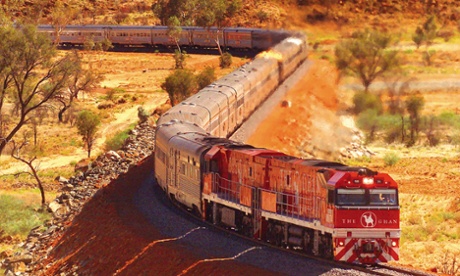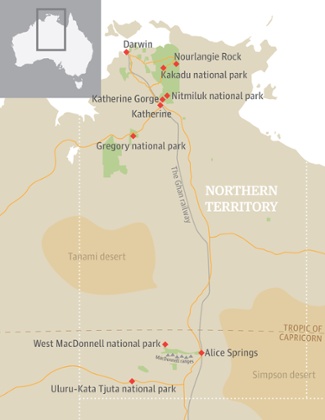
The sun is already on its descent, turning the sky’s unblemished blue to violet, and the ancient walls of Kakadu’s Nourlangie rock to glowing ember red, when we start our search for the alyurr, the Aboriginal name for Leichhardt’s grasshopper.
“If we find this, we’ll likely find the alyurr,” says Dave, my guide, adjusting his wide-brimmed Akubra for the mission, and pointing to a photograph in his nature journal.

“Pityrodia jamesii is one of the host plants of the spectacular Leichhardt’s grasshopper,” reads the caption. I study the picture, then look at the landscape that stretches towards Nourlangie. To my untrained eye, the brick and cobalt coloured bugs we seek could be hiding under any one of the shrubs before us. Unfazed, Dave closes the journal and heads into the bush.
Pristine wetlands and lush rainforests
Just three hours drive east from Darwin, Kakadu national park, a Unesco world heritage site, is one of the planet’s last untouched wildernesses. Covering 20,000 sq km, it’s home to pristine wetlands, lush rainforests, crystal pools and abundant wildlife.
Soaring escarpments secrete ancient galleries of some of the planet’s oldest rock art: 50,000-year-old stories painted in hematite and ochre, shedding light on the lives of the region’s traditional owners – the Bininj-Mungguy – the animals that share their land, and the powerful ancestral beings that shaped their country.
To them, the grasshoppers we seek aren’t just rare, beautiful bugs, they’re alyurr: the offspring of Namarrgon, the Lightning Man, appearing each year to herald a pending electrical storm.
“The traditional land owners’ relationship to ‘country’ is very strong,” says Dave, as we venture down a forested trail. “Country takes in all aspects of the landscape, and the local people have custodial responsibility to look after everything that lives within it.”
Kakadu’s custodians have done well. Earlier that afternoon, from the rocky outcrop of Ubirr, I’d gazed across the forests and floodplains that stretch to the plateau of almost-mythical Arnhem Land, searching for the usual invasive signs of human life. There were none.
Instead, back on the trail near Nourlangie, it’s the Lightning Man who has left his legacy. Perched on a patch of pityrodia, the elusive Leichhardt’s siren blue and red – Namarrgon’s kids have come home.
The stillness of the desert
There’s nowhere else on the planet like the Northern Territory. And unless you’ve driven its outback highways, soaked up the stillness of its deserts, roamed its diverse national parks and encountered its native wildlife, you haven’t really experienced Australia. Sydney has shopping, Melbourne has music, Perth the sun and Cairns the reef, but the Northern Territory has limitless horizons, interminable spirit and a raw, wild beauty all of its own.
Despite its untamed nature, exploring the state is stress-free, with fast, paved roads linking the main attractions and towns, quality tours to suit all ages and budgets, and a range of accommodation from wilderness campsites to high-end lodges overlooking, arguably, the world’s most stunning natural sights.
For a view on the move, the Ghan train carries guests on a two-day trip from cosmopolitan Darwin to the legendary outback town of Alice Springs. Private cabins and elegant dining cars bring old-school glamour to one of the all-time great rail journeys, and passengers have the chance to hop off mid-trip to cruise or canoe Katherine gorge in Nitmiluk national park. Traditional owners of Nitmiluk, the Jawoyn, lead tours to see 40,000-year-old indigenous rock art and the crocodiles, wallabies and turtles that call the gorge home.
But you don’t need to visit a national park to experience the unique wildlife of the Northern Territory. The state boasts 400 species of birds, 150 mammals, 300 reptiles, 50 frogs and several hundred species of fish, so driving its highways at any time of year yields exciting animal encounters.
Majestic wedge-tailed eagles swoop overhead; frilled lizards flare their necks as they whiptail up trees; flocks of wild budgerigars flash by your window; and kangaroos dutifully bound through the bush for the compulsory outback photocall: this is road-trip bingo gone wild.
Approaching Australia’s heart, as umber earth gives way to red sand, dunes provide sanctuary for thorny devils, spiky, modern-day dinosaurs that fit the palm of your hand; perenties, Australia’s largest lizards; and dingoes, inquisitive wandering wild dogs, introduced from Asia around 4,000 years ago. It’s a land of vast, starry skies, dramatic canyons, towering rock formations and desert dwellers; a place to connect with ancient cultures and slow to the rhythm of the outback; a lost world with a landscape unchanged for millions of years.
A world of colour
Raising the blind of my floor-to-ceiling window at Longitude 131°, the luxury retreat on the threshold of Unesco world heritage site, http://www.parksaustralia.gov.au/uluru/, I feel like Dorothy, swinging open the black-and-white door of her Kansas home and letting the technicoloured wizardry of Oz flood in. “Red centre” does not do the dazzling desert palette justice: in one day alone, mesmerising Uluru glows from a purple haze to salmon pink, via burnt orange and deep crimson.
, I feel like Dorothy, swinging open the black-and-white door of her Kansas home and letting the technicoloured wizardry of Oz flood Uluru-Kata Tjuta national park. “Red centre” does not do the dazzling desert palette justice: in one day alone, mesmerising Uluru glows from a purple haze to salmon pink, via burnt orange and deep crimson.
Up close, the 348-metre monolith is rippled, scarred and studded with caves: wounds from ancient battles and footprints from epic journeys captured in the Tjukurpa – creation stories of Uluru’s traditional owners, the Anangu, custodians of one of the world’s oldest cultures.
I walk its base one morning with an Anangu elder. Zebra finches dart among the river red gums as skittish wallaroos navigate the spiked clumps of spinifex grass. Lizard and emu tracks crisscross the ochre sand, while my guide points to snake trails streaking the sacred stone, ancient markings left by the creators as they moved across the land.
Over a million wild camels roam Australia’s central deserts, descendants of the animals that carried 19th-century pioneers and Afghan traders into the country’s interior, released to run free when motor vehicles became the transport of choice. In the late afternoon, a train of tamed dromedaries carries me – and fellow revellers – across the sand to enjoy canapes, wine and a bush-tucker buffet, overlooking the sunset-soaked canvas of Uluru.
Over dinner, a ranger guides us on a star talk through the southern night sky. With Orion’s hunting dogs, Canis Major and Minor, sparkling silently above, the rock radiates its eternal presence across the timeless desert, as a dingo’s howl drifts across the dunes.
Trailfinders – tailormade holidays to suit you
Explore the tropical top end by motorhome, taking in the lush wetlands, cascading waterfalls and rugged rock escarpments of the surrounding national parks. Combine this with the dramatic scenery and ancient Aboriginal culture of the spectacular red centre, easily explored by car. Fourteen-night holidays start from £1,699 including flights, two nights in a Darwin hotel, seven nights motorhome hire and five nights in hotels in the red centre with car hire – call Trailfinders on 020 7368 1200 to book.
How to get there
Fly to Australia with Malaysia Airlines which has twice-daily flights from London Heathrow to Sydney and Melbourne, plus daily connections to Brisbane, Adelaide and Perth and four connections to Darwin every week. Prices for return flights from London to Australia start from just £649. For more information and to book, visit malaysiaairlines.com







